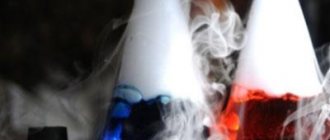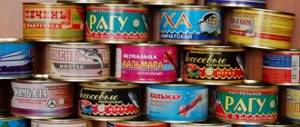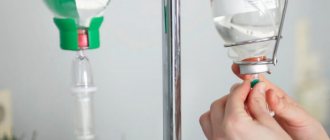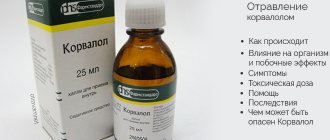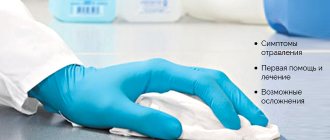One of the causes of death in cattle is poisoning. If a cow is poisoned, you need to act quickly - poisons and toxins, once in the stomach, are absorbed into the blood and can lead to the death of the animal. This article will discuss the causes of poisoning, methods of providing emergency assistance for various types of intoxication and preventive measures.
Causes of poisoning
Cows are not very picky about what they eat, so they often suffer from poisoning. How a cow can be poisoned:
- Poisonous grass, such as alfalfa, lupine, hemlock, fern or sudanese, acorns.
- Poisonous mushrooms.
- Potatoes that were lying in the sun. Such root vegetables accumulate a toxic substance - solanine, which causes severe poisoning in cattle.
- Beetroot (cows are not allowed to give a lot of these vegetables at one time).
- Chemical compounds, pesticides - copper salts, mercury, arsenic, nitrates, pesticides.
- Salt - if a cow eats a large amount of salt, it becomes poisoned.
- Mold - the animal eats hay of poor quality, infected with fungus, which causes severe intoxication of the body.
The causes of poisoning include the following factors:
- Lack of feed quality control.
- Grazing animals in fields and pastures where fertilizers are used.
- Inattention to animals.
Timely diagnosis of poisoning is very important. If poisons enter the animal's body, death often occurs. In order to provide timely help to a cow, you need to know what symptoms arise from poisoning with various substances.
Fatal cow poisoning
What can poison a cow?
Even if the cow’s immunity is good, substances that can cause intoxication may still come across.
The most common causes of poisoning are:
- Poor quality, expired or sour food, along with which pathogenic microorganisms penetrate inside.
- Getting into the gastrointestinal tract along with food of undecomposed pesticides with which this food was previously treated.
- Consumption of heavy metal salts from the same pesticides and other fertilizers with food.
- Large amounts of salt, consumed with food or separately, also cause poisoning.
- Eating poisonous plants, green potatoes, mushrooms.
- Exceeding the consumption of beets, which in large quantities can lead to poisoning.
- Intentional poisoning of an animal.
When grazing a cow, you need to check the area and make sure that there are no plants there that can poison the animal - buttercup, lupine, sudanese, hemlock, horsetail, henbane, cross grass, and others that contain alkaloids in high concentrations.
These herbs can cause severe damage to internal organs. For example, cattle eating cross grass can be fatal due to liver and kidney damage. And foxglove and hemlock paralyze the nervous system and lead to the rapid death of the animal.
Symptoms
Poisoning in cows is quite pronounced. Let's look at its symptoms in detail:
- Bloating.
- Diarrhea (stool changes color, mucus, blood, and foamy inclusions are found in it).
- Vomit.
- Depressed state, the animal often lies with its limbs outstretched.
- The gait is unsteady.
- Breathing is frequent, heart rate is accelerated.
- Profuse salivation.
- The pupils are constricted or dilated.
- The oral mucosa is bluish (in case of arsenic poisoning) or red with ulcers (if mercury has entered the body).
Important! When poisoned by certain poisons, the animal becomes overly excited and convulsions may begin.
If you observe such symptoms, you need to act immediately, because the poison that enters the stomach continues to be absorbed into the blood, thereby aggravating the cow’s condition. How to help a cow?
Diagnostics
The initial analysis of the cow's condition is usually carried out by the owner of the livestock farm. After the first signs of a health problem in the livestock, it is necessary to begin diagnosing and analyzing the reasons why the cow was poisoned. Experts emphasize the importance of conducting a quick examination, since within 2-3 hours after poisoning the condition of cattle can noticeably deteriorate.
It is recommended to invite a specialist to carry out an accurate diagnosis and identify the reasons why the animal is sick. This is necessary to understand what exactly the cow was poisoned with and what antidote can be used in this case.
Emergency help
Treatment of poisonings should be carried out by an experienced veterinarian. If chemicals enter the cow's body, rumen puncture is sometimes used as an emergency measure, as well as various antidotes, substances that neutralize the effects of poisons and toxins in the body. Let's look at how emergency therapy is carried out in different situations.
- If a cow has eaten poisonous grass, acetic acid diluted with water is used as an antidote. The solution should have a concentration of 0.5%. No more than 2 liters of the product are injected into the cow’s stomach, due to which poisons from plants are not able to be absorbed into the blood. In parallel, washing with a solution of potassium permanganate at a concentration of 0.1% is used. Glucose is administered intravenously, as well as a solution of methenamine (10%).
- For mercury poisoning, Strizhevsky's antidote is used. After neutralizing the poison, the animal is given milk or mucous decoctions to create an enveloping film in the stomach.
- In case of nitrate poisoning, methylene blue is used, after which the stomach is washed through a tube.
- If the cause of intoxication is copper salts, the stomach is washed with water with the addition of charcoal. Along with this, a glucose solution is administered intravenously.
- If a cow has eaten arsenic along with food, the stomach is washed with a solution of burnt magnesia at a concentration of 1%. After the cleansing procedure, the cow is given oily emulsions or milk.
- In case of beet poisoning, it is necessary to rinse the stomach generously with a solution of potassium permanganate, give a subcutaneous injection of insulin to lower blood sugar levels, and inject a solution of sodium chloride (5%) into a vein.
In cases of severe depression of the nervous system, injections with caffeine are used. If the animal is overly excited, chloral hydrate is administered intravenously.
Attention! It is unacceptable to treat a cow with severe poisoning without experience in veterinary medicine. An incorrectly selected antidote or injection solution can be fatal.
After emergency treatment, your veterinarian will give detailed instructions on further treatment.
Methods for preparing an antidote
Antidotes can be prepared to cope with dangerous components that have entered the body of livestock. In each specific situation, the scheme for their preparation and administration is different:
- grass poisoning of a sheep - a vinegar mixture diluted with water is suitable. The permissible concentration of the solution is 0.5%. The drug is administered into the stomach in an amount of two liters. You also need to rinse using a manganese solution (0.1%);
- beets - use a solution of potassium permanganate for washing. After this, insulin is injected under the skin to stabilize blood sugar. At a concentration of 5%, sodium chloride is injected directly into a vein;
- mercury - in this situation it is appropriate to use a special antidote developed by Strizhevsky. When the toxic substance is neutralized, the cattle are given a decoction of the mucous components. The stomach is protected by a film that envelops it;
- nitrates - the stomach is washed with methylene salt, and then special solutions are used;
- copper salts - cattle need to immediately rinse their stomach with a solution to which charcoal has been added. Also inject a glucose solution into the vein;
- arsenic - if an individual manages to eat this drug, then urgently rinse its stomach with a solution of burnt magnesia (1%). Then you need to give your pet milk to drink, which is not diluted with water.
Treatment
Further actions regarding the treatment of the cow include ensuring her complete rest. In the first two days after poisoning, the animal is not fed, but only offered something to drink . At the same time, they continue to give sorbents that will help remove the remaining toxic substances from the body.
In the first 2 days the animal is only given water
When the health status has stabilized, it is allowed to introduce various mash into the diet - flour, oatmeal. As the animal develops an appetite, it is gradually transferred to its usual diet.
Prevention
To avoid poisoning in cattle, farmers need to carefully monitor the quality of feed. It is important to store hay properly to prevent mold from appearing in it. Potatoes intended for animal feeding must be stored in a dark place, otherwise the toxin solanine will accumulate in the tubers.
Cows should not be released onto pastures that have recently been treated with fertilizers or other chemicals. It is prohibited to wash containers in which toxic substances were stored in water bodies where animals drink. To avoid poisoning cows with beets, it is unacceptable to feed them more than 10-12 kilograms of root vegetables per day. Careful control of feed quality will help avoid cattle poisoning.
Poisoning is a common cause of death in cattle on farms. Its danger lies in the fact that the animal’s condition quickly deteriorates - dehydration, general depression, convulsions, paralysis, and then death occur. If you notice the first symptoms of poisoning in a cow, immediately contact your veterinarian. To prevent such situations, carefully monitor the quality of the feed and store it away from chemicals.
Feed poisoning in cows requires immediate treatment, otherwise the animal may die .
Any farmer or rural resident should know the main signs and symptoms of cattle poisoning, as well as the reasons why it occurs. This will give you time to take appropriate measures.
Salmonella
Infection with salmonella is called salmonellosis or calf paratyphoid fever. Young individuals feeding on mother's milk are most susceptible to infection. Let's find out what symptoms this disease may have:
- a sharp rise in temperature;
- breathing disorder: shortness of breath appears, the cow breathes shallowly, sleeps and wheezes;
- a classic picture, like food poisoning: diarrhea and vomiting, sometimes with blood;
- gait is disturbed, as the inflammatory process spreads to the joints and bone tissue.
The danger lies in the fact that it is difficult for a person to distinguish the onset of salmonellosis from ordinary poisoning, for this reason treatment often begins when there is no point in it.
Poisoning factors
As a rule, poisoning of the body of any animal occurs due to the same factors as human intoxication - toxic substances enter the body, which lead to disruption of the functioning of all body systems. Cows are classified as herbivores, which means their gastrointestinal tract has an unusual structure. The intestines have low resistance to putrefactive bacteria and other dangerous microorganisms . If a cow is poisoned, a number of reasons could provoke this phenomenon:
- Ingestion of pesticides (fertilizers, pesticides) used in rural areas to control weeds and also to improve crops.
- Eating spoiled or low-quality food by animals.
- Eating poisonous mushrooms or plants, potatoes turned green by the sun.
- Overeating alfalfa, corn shoots and other plants. This can happen if the cow ends up in a field where such crops are grown. Therefore, when taking cattle out to pasture, they need to be closely monitored.
- Plants containing alkaloids are dangerous for cows. These are buttercup, horsetail, henbane and others. As a result of their consumption, the internal organs of livestock are affected. Some plants are particularly toxic . For example, ragwort leads to damage to the kidneys and liver, resulting in the death of the animal in a few days. And hemlock leads to paralysis of the nervous system, so the cow will die in 4-5 hours. In both cases, treatment is not carried out, since there is no antidote for these plants. The cattle are immediately sent to slaughter.
- Ingestion of heavy salts into the intestines. For example, copper salts cause lethargy and stool turns green. If you start treating the animal in time, you can save it. The degree of intoxication depends on how many toxic substances are in the cow’s body.
Potato poisoning is very dangerous for cattle. Therefore, animals should not be given last year’s potatoes. It contains solanine, which leads not only to the appearance of symptoms of intoxication, but also to a disorder of the nervous system of cows.
Probiotic "Symbitox"
has developed an effective remedy for the prevention and elimination of the consequences of cattle poisoning. The probiotic “Simbitox” is an adsorbent of mycotoxins and allows you to effectively combat intoxications of various natures. The therapeutic and preventive complex contains high-quality drugs, each of which is aimed at solving a particular problem. As a result of using the probiotic “Simbitox”, the cow’s body is cleansed, the digestive system improves, appetite improves, and natural protection against toxins increases. The effectiveness of the drug has been proven by laboratory tests and studies, as well as many years of practice by specialists.
Signs and symptoms of intoxication
Symptoms of cattle poisoning depend on the type of toxin ingested. As a rule, signs of intoxication appear several hours after pathogenic substances enter the cow's intestines . Very rarely, symptoms appear within a day (for example, with heavy metal poisoning). In this case, the general signs of intoxication are as follows:
- vomiting, diarrhea, constipation. The cow's belly becomes very distended, and blood particles are observed in the feces and urine;
- the functions of the nervous system are impaired. The animal becomes excited and restless. In some cases, parts of the cow's body are paralyzed, it becomes immobile, and staggers while walking. Often there is also no reaction of the body to external stimuli;
- the pupils do not react to bright or dim light, but remain constantly only in a dilated or constricted state;
- the temperature rises, the animal breathes heavily, the pulse changes - it either becomes too fast or, conversely, slows down;
- mucous membranes dry out. Less commonly, there is profuse drooling and lacrimation, and a runny nose.
- Muscle spasms appear, muscles become tense. The cow eats worse, but the amount of urine increases.
If first aid is provided immediately after the animal has eaten a dangerous product, symptoms may not appear. However, if the poisons are absorbed into the blood, the help of a veterinarian is necessary , otherwise the cow may die.
Non-communicable disorders
This group of diseases causes maximum damage to livestock, often leading to their death. The owner must at least learn to recognize the first signs of the disease in order to begin treatment on time. Otherwise, there is a high probability that the cattle will die and the calf’s disease will spread to other domestic animals.
It is worth saying that diseases should only be described comprehensively, that is, telling everything in order: symptoms, disease and treatment of calves, as well as preventive measures. What infectious diseases of calves are most common? This:
- Diplococcus;
- Colibacillosis;
- Criprosporidium;
- Salmonella;
- Enteritis;
- Desentery.
Cow diseases are divided into two groups:
- infectious (smallpox, lichen, actinomycosis);
- non-infectious (poisoning, abscesses).
As for the signs and characteristic symptoms, they often overlap with infectious ones, which complicates diagnosis. To make an accurate diagnosis, it is better to use the services of a veterinarian.
Which non-contagious calf diseases are considered the most dangerous for calves:
- pneumonia and bronchitis (refer to respiratory diseases of calves);
- white muscle disease;
- rickets;
- tympany;
- enteritis;
- bezoar disease.
This is vaginitis, problems with the udder and nipples. The parasitic variety is trichomoniasis.
Vaginitis
The development of this disease is usually caused by improper living conditions for livestock: unbalanced nutrition or unsanitary conditions of the premises. White muscle disease often affects young animals, especially those calves that are breastfed.
White muscle disease is also called muscular dystrophy, since it affects the muscles, depleting them to the limit. If the disease occurs in winter, then more than half of the brood may die, even though this disease is not considered contagious.
Here, the large number of sick livestock is explained by the fact that the conditions are the same for everyone.
How to recognize the onset of the disease? The first symptoms usually appear in the first months of a calf’s life, that is, this is one of the diseases of newborn calves up to 3 months of age. Externally, a change in gait, a decrease in physical activity, and even rare convulsions are noticeable.
Also, muscular dystrophy negatively affects the respiratory and cardiac systems, shortness of breath appears and the heartbeat is disturbed. It is worth saying that these changes are irreversible, that is, they do not return to normal even after treatment.
Rarely, white muscle disease can be fatal. Death usually occurs when disruption of vital systems leads to depletion of the heart muscle and the appearance of pulmonary dysfunction.
Like all previous described diseases, bezoar disease affects young animals, that is, those calves that are fed milk or have recently been weaned from their mother’s udder. The disease is considered so dangerous that it can affect entire herds, often leading to death. The peak incidence occurs in the winter months, although outbreaks can occur at any time of the year.
What is bezoar disease? This is primarily a disorder in the digestive system. During this illness, undigested clots from food particles and hair form in the gastrointestinal tract.
These lumps interfere with normal digestion of food.
First aid
What to do when a cow is poisoned by toxic substances? Emergency assistance is urgently needed. If it is possible to quickly bring a veterinarian, then it is better if urgent treatment is carried out by a doctor. The animal is given an antidote that helps eliminate toxins .
In case of intoxication with chemicals, the side of the abdomen is pierced, piercing the scar. It is very important to give the cow plenty to drink so that toxins are eliminated in the urine. All antivenoms must be used according to instructions. If first aid was provided by the owner of the animal, and then no signs of poisoning appeared, you still need to call a doctor. He must examine the cow to confirm if she is okay.
Routes of infection
Actinomyces bovis is able to penetrate into the animal’s body through damaged epidermis or epithelial tissue. Infection with actinomycosis can occur through tissues in the oral cavity, legs, udder, etc. Often, infection with this pathogenic microorganism occurs while eating feed in which its spores or micelles are present. In such a situation, the infection enters the body through carious lesions, wounds on the tongue and gum tissue, walls of the digestive tract, etc.
When the fungus enters the cow’s body, active damage to nearby tissues begins. The disease becomes generalized after the pathogen enters the circulatory system. In such a situation, the mycelium grows throughout the body. This leads to the occurrence of metastases in the individual and the formation of new abscesses.
Granulomas caused by exposure to radiant fungus contain large numbers of drusen (colonies) of Actinomyces bovis. When the abscess opens and a fistula forms, the spores penetrate into the surrounding tissues simultaneously with purulent exudate. This contributes to the further spread of infection.
Often, the development of actinomycosis in cattle is observed during the stall period (during the cold season), when infected hay can be used as feed. If an epidemic begins, most often about 10% of the population becomes infected. Moreover, cows and other farm animals of any age can be infected. Actinomycosis can be detected not only in an adult dairy cow or a stud bull, but also in a very small calf.
Moreover, transmission of infection is possible both with roughage and water. In addition, there is a risk of Actinomyces bovis infection in animals kept in a dirty barn. In such a situation, the fungus can easily enter the cow’s body, for example, through cracks in the mammary glands or legs through infected bedding.
Treatment
During the treatment process, the following drugs are used for cow poisoning:
- adsorbents that promote the rapid removal of toxic compounds from the body. These include white clay and activated carbon. Adsorption is carried out immediately after the cow has eaten the toxic substance. If the toxin is absorbed into the blood, adsorbents will not help ;
- An antidote is an antidote with a chemical composition. This compound neutralizes the poison. For example, in case of urea poisoning, formalin is injected into the cow. As a result of the chemical reaction, the poison becomes absolutely harmless to the animal.
- physiological antidote. This is a substance that eliminates the interaction of poison and biological tissues;
- laxatives. It is also recommended to use immediately, before the poison is absorbed into the blood. In this way, the entire contents of the intestine will be cleansed along with the feces;
- caffeine is used to suppress the nervous system. Under his influence, the cow becomes more cheerful. Chloral hydrate is also used for disorders of the nervous system, but, unlike caffeine, it relieves excitement;
- Glucose is introduced into the animal's body during severe diarrhea or vomiting to avoid dehydration.
If poisoning is caused by mercury compounds, the cow lies down and does not get up. In this case, the animal urgently needs to be administered Strizhevsky’s antidote. Immediately after administration, it will begin to act, removing the toxic substance. After 2 hours, milk or a protein decoction is introduced into the gastrointestinal tract, which envelops the gastric mucosa.
In addition, it is recommended to rinse the stomach of the sick individual . Clean water should not be used for rinsing, as it will only dilute the poison, causing it to be absorbed into the blood faster. Use a solution with tannin or potassium. It is advisable that the procedure be performed by a veterinarian, otherwise you can only harm the animal. After the washing is completed, special enveloping solutions are poured into the cow’s mouth.
Recognizing intoxication in a calf
If a calf has been poisoned or you notice primary signs, treatment should be immediate. Perform gastric lavage using special compounds. After this, it is worth giving the baby drugs that will not allow the poisons remaining in his body to act further. Signs are a bloated belly, lethargy, overexcitement, lack of response to stimuli, and so on. If you notice even one symptom, contact your veterinarian immediately to help diagnose the problem.
Preventive measures
Cows eat fresh or dry grass. To avoid food poisoning, you need to carefully monitor what the cow eats. The quality of grass and hay must be high . It is better to make hay for the winter yourself, drying only plants allowed for the cow.
Animals should not be grazed in areas where chemical fertilizers have been applied to the soil. Particular attention should be paid to the watering hole. It is advisable to give water in a bucket from a well, rather than take the cow to a river, since chemicals used to fertilize the soil and control weeds flow into it.
If the cow has already been poisoned, immediate action must be taken. If possible, it is recommended to call a veterinarian at home . You cannot hesitate, because in some cases even minutes can affect the outcome.
Poisoning of cows most often occurs during the grazing period, when operators who care for the livestock cannot control what the animals eat on free grazing. Experts recommend carefully checking the walking area. It is necessary to remove foreign objects and poisonous plants from the pasture, if possible.
Cows can become poisoned while in stalls during the winter. This happens due to low-quality feed, which is stored in violation of technology.
Symptoms of poisoning are observed in livestock if they were placed in a barn where they were disinfected or treated for insects and helminths. How to recognize that animals have been poisoned? What help should be given to them first?
Safety when feeding cattle
If a cow has been poisoned by grass, then you should carefully choose the place where she will graze. It is necessary to make sure that there are no plants treated with poisons on the territory. If you don't know what can make a cow sick, read the list of dangerous plants described above. Make sure they are not on site to eliminate the risk of an accidental problem. Poisoning of sheep, the treatment of which is difficult, like diseases of other types of livestock, can be caused by the animals consuming low-quality feed. Pay attention to whether it has an unpleasant odor. The presence of mold in the mixture indicates its deterioration. This is why you should not buy questionable food to protect your pets from illness.
source
